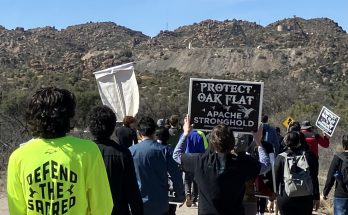How I sought peace, but found the phantom of war in Arizona
It was Sunday, my second one in Arizona. I decided to go to the church, because my family was doing the same in my hometown Yerevan that very day, having the memorial service in Saint Anna, the beloved church of my father who passed away a couple weeks ago.
The weather was hot, as torrid as it can be in Phoenix at the beginning of September. Unreliable public transport on Sundays works even worse here, so I decided to walk. I just googled the nearest church location and went off in the scorching sun. In ten minutes I came to a City of Grace, which looked like a Catholic church, but it was actually an Evangelical one, like the Pentecostals or the Word of Life active in Armenia. I entered, driven by interest and heat. At the door, a gentleman with red wireless headphones and a swanky outfit invited me in with a broad smile. Before reaching the hall, I met a few more friendly people who greeted me with emphatic benevolence. Obviously new people are welcome here, I thought.
The crowd was big inside and the air conditioning worked well. A handsome, tall and thin white guy preached. It seemed to me he was reading from a teleprompter, because his eyes constantly went down the scene.
My English is not so fluent to fully grasp the nuances of the sermon, but that boy was doing great, and most importantly, people liked him. The crowd was constantly shouting and clapping. Then there was light rock music.
They turned off the lights in the hall. The effect was strong. At some point, I felt sweat pouring profusely from my face. For a moment it seemed like I was being cleansed of evil thoughts by supernatural grace. Then, leaving the building, I realized that the reason for my sweat was perfectly natural. When I was outside, the liquid on my skin immediately evaporated at 113F heat, but after going inside the cooled premises, sweat just kept flowing abundantly and visibly from my heated body. Unfortunately, this prosaic interpretation made more sense than the previous supernatural one.
Anyway, I got out, walked a few more hundred meters under the blazing sun along Monroe Street and reached St. Mary’s Basilica, home of the oldest Catholic parish in Phoenix. Built at the beginning of the 20th century, it looks quite modest. Much more humble than the mansions built by average public officials in the wealthy district of my native Yerevan. The only thing in common was brown cladding, scanty vegetation and artificial lawn outside the building. But inside I felt a completely harmonious atmosphere. Mass here is served three times on Sundays – at 7:30, 9:00 (broadcasted on YouTube) and 11:30. In other words, people can participate in religious ceremonies without burdening the temple with physical presence.
It was the first time I attended mass in the Catholic cathedral, but it felt very familiar. First and foremost because of the music, which is somewhat similar to Armenian church singing and to European music of the Baroque era in general. Besides, there were many believers of Mexican origin. No wonder, since Arizona is the penultimate state to join the United States and it borders Mexico. Mexicans are very similar to Armenians not only anthropologically, but also in the way they dress – bright clothes and striking makeup in most women, which is less usual for other Americans.
Inspired by the church experience that Sunday, I searched for more next week and found an Armenian Apostolic church and cultural center in Scottsdale, about 40 kilometers from my home in downtown Phoenix. After a grueling public bus ride I arrived two hours late, towards the end of the Liturgy.
Usually the house of God “rises to the sky”, but contrary to the traditions of Armenian sacral architecture, here the church was very low and seemed like squatting. Having had a stint of work experience in the Yerevan City Hall, I immediately realized that also here the City must have dictated the standards of construction, limiting the height of the temple. Anyway, I went in and immediately felt the suspicious look of an elderly man at the door, directed at my backpack. I smiled, said hello in Armenian and offered to open my backpack. The man did not smile, but invited me inside without checking the bag.
The Armenian liturgy was quite modest, the choir consisted of two people and there was no organ. The priest delivered a sermon in a mixture of two Armenian dialects and English. Afterwards members of the community gathered at the lunch table, and I began to get acquainted with them, mainly middle-aged people.
Car mechanic Makar* came to Arizona from Iraq in 1981 to escape the Iran-Iraq war. Gevorg, a member of the community’s board, a very active man interested in global politics, came to the US from Armenia in 1992 to escape the First Karabakh war. Mrs. Gohar now teaches English to immigrants at a public school in Phoenix. She was an English teacher in her native Aleppo, where her family lived until the Arab Spring began in 2011 and she was forced to flee when ISIS took over the city. A successful businessman, young Sargis recently came to study in Arizona. His parents live in California, where they arrived in the mid-70s from civil war-torn Lebanon.
Ancestors of all these Armenian people appeared in Lebanon, Syria, Iraq, the US and many other countries since the First World War, when the Ottoman Turkey subjected to genocide and deportations more than 1.5 million Armenians.
These people once left their homes to escape the war, but the theme of the war does not leave them at all. Even today, in the peaceful valley of Arizona, they discuss how the war unleashed by Russia in Ukraine now affects the US economy. And how hundreds of people’s lives are taken every year by the permanent war which is going on between Armenia and neighboring Azerbaijan. Conflict still drags on, the second major escalation occurred in 2020, taking at least 7000 lives. In September this year at least 300 more people were killed as a result of the Azerbaijan attack on Armenia, which was condemned by governments of the United States, India and major European countries.
So my journey to the church in search of inner peace and cultural exchange brought me back to the painful realization that the phantom of war is always present – even thousands of kilometers away from the battlefields.
- During the eight years of the Iran-Iraq war, about 700,000 people died on both sides, including at least 20,000 civilians. Both countries suffered huge economic losses.
- During the Lebanese Civil War (1975-1990), up to 150,000 people died. Тhe country cannot overcome the economic consequences so far.
- During the civil war in Syria, which began after 2011, more than 300 thousand people died, including about 70 thousand civilians. More than 4 million people became refugees.
- During the first Karabakh war of 1991-1994 between Azerbaijan and the unrecognized Nagorno-Karabakh Republic supported by Armenia, up to 25 thousand people were killed on both sides, up to a million were displaced. The second major escalation of the conflict occurred in 2020, with at least 7,000 deaths according to official sources. The armed phase of the conflict is still active. As a result of Azerbaijan’s attack on the sovereign territory of Armenia in September of this year, at least 300 people were killed on both sides. The governments of the United States, India, France and a number of European institutions have condemned the aggressive actions of Azerbaijan.
*All names have been changed for the sake of privacy.




